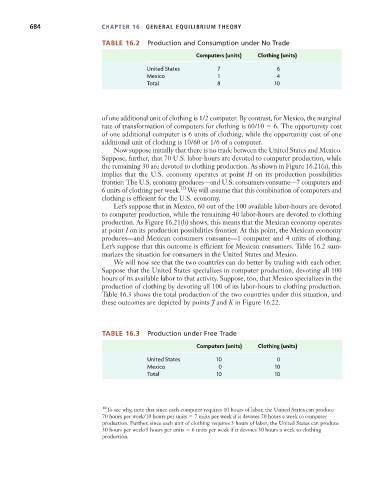Page 710 - Microeconomics, Fourth Edition
P. 710
c16GeneralEquilibriumTheory.qxd 8/16/10 9:14 PM Page 684
684 CHAPTER 16 GENERAL EQUILIBRIUM THEORY
TABLE 16.2 Production and Consumption under No Trade
Computers (units) Clothing (units)
United States 7 6
Mexico 1 4
Total 8 10
of one additional unit of clothing is 1/2 computer. By contrast, for Mexico, the marginal
rate of transformation of computers for clothing is 60/10 6. The opportunity cost
of one additional computer is 6 units of clothing, while the opportunity cost of one
additional unit of clothing is 10/60 or 1/6 of a computer.
Now suppose initially that there is no trade between the United States and Mexico.
Suppose, further, that 70 U.S. labor-hours are devoted to computer production, while
the remaining 30 are devoted to clothing production. As shown in Figure 16.21(a), this
implies that the U.S. economy operates at point H on its production possibilities
frontier: The U.S. economy produces—and U.S. consumers consume—7 computers and
6 units of clothing per week. 10 We will assume that this combination of computers and
clothing is efficient for the U.S. economy.
Let’s suppose that in Mexico, 60 out of the 100 available labor-hours are devoted
to computer production, while the remaining 40 labor-hours are devoted to clothing
production. As Figure 16.21(b) shows, this means that the Mexican economy operates
at point I on its production possibilities frontier. At this point, the Mexican economy
produces—and Mexican consumers consume—1 computer and 4 units of clothing.
Let’s suppose that this outcome is efficient for Mexican consumers. Table 16.2 sum-
marizes the situation for consumers in the United States and Mexico.
We will now see that the two countries can do better by trading with each other.
Suppose that the United States specializes in computer production, devoting all 100
hours of its available labor to that activity. Suppose, too, that Mexico specializes in the
production of clothing by devoting all 100 of its labor-hours to clothing production.
Table 16.3 shows the total production of the two countries under this situation, and
these outcomes are depicted by points J and K in Figure 16.22.
TABLE 16.3 Production under Free Trade
Computers (units) Clothing (units)
United States 10 0
Mexico 0 10
Total 10 10
10 To see why, note that since each computer requires 10 hours of labor, the United States can produce
70 hours per week/10 hours per units 7 units per week if it devotes 70 hours a week to computer
production. Further, since each unit of clothing requires 5 hours of labor, the United States can produce
30 hours per week/5 hours per units 6 units per week if it devotes 30 hours a week to clothing
production.

